Hey there 👋 We heard you need some help integrating Placid MCP into your AI workflows?
Here are all infos and a complete walkthrough to help you get your creative automation up and running. If you run into troubles and need extra support,
What can I do with Placid MCP?
MCP (Model Context Protocol) is a standardized way to make external tools and APIs like Placid available in AI workflows and tools.
With our MCP, you can use Placid like a plugin for your AI applications. They will know exactly what Placid does and have all the tools they need to turn your natural language prompts into generated creatives.
Examples
Create an Instagram feed image with the quote "Peace of mind is experienced only after making peace with your mind" using the Placid MCP
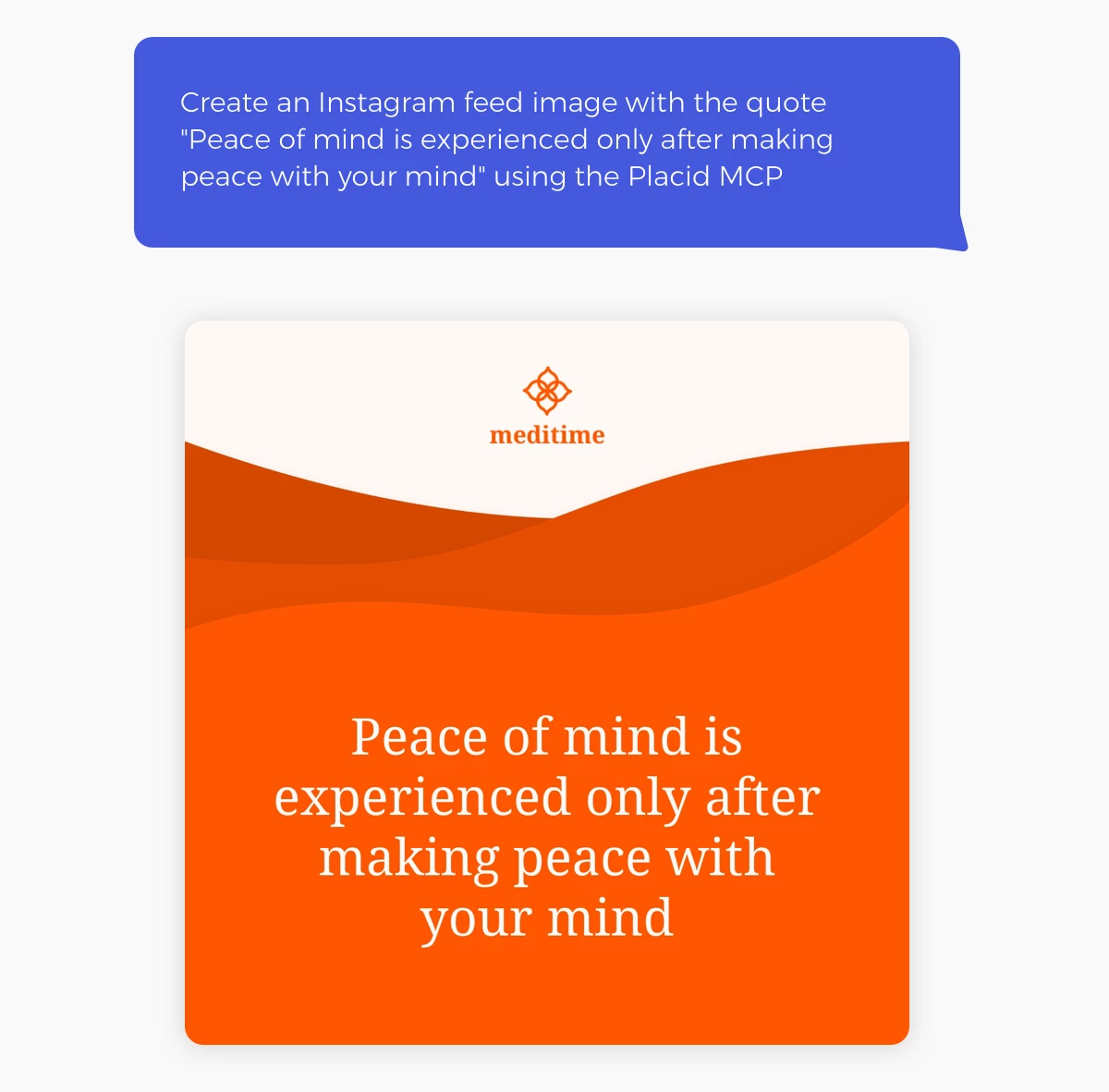
Fetch the headlines of the latest 3 articles on cnn.com and create a news teaser video with them using the Placid MCP

Create a course certificate PDF for John Doe, dated 2023/12/10 using the Placid MCP
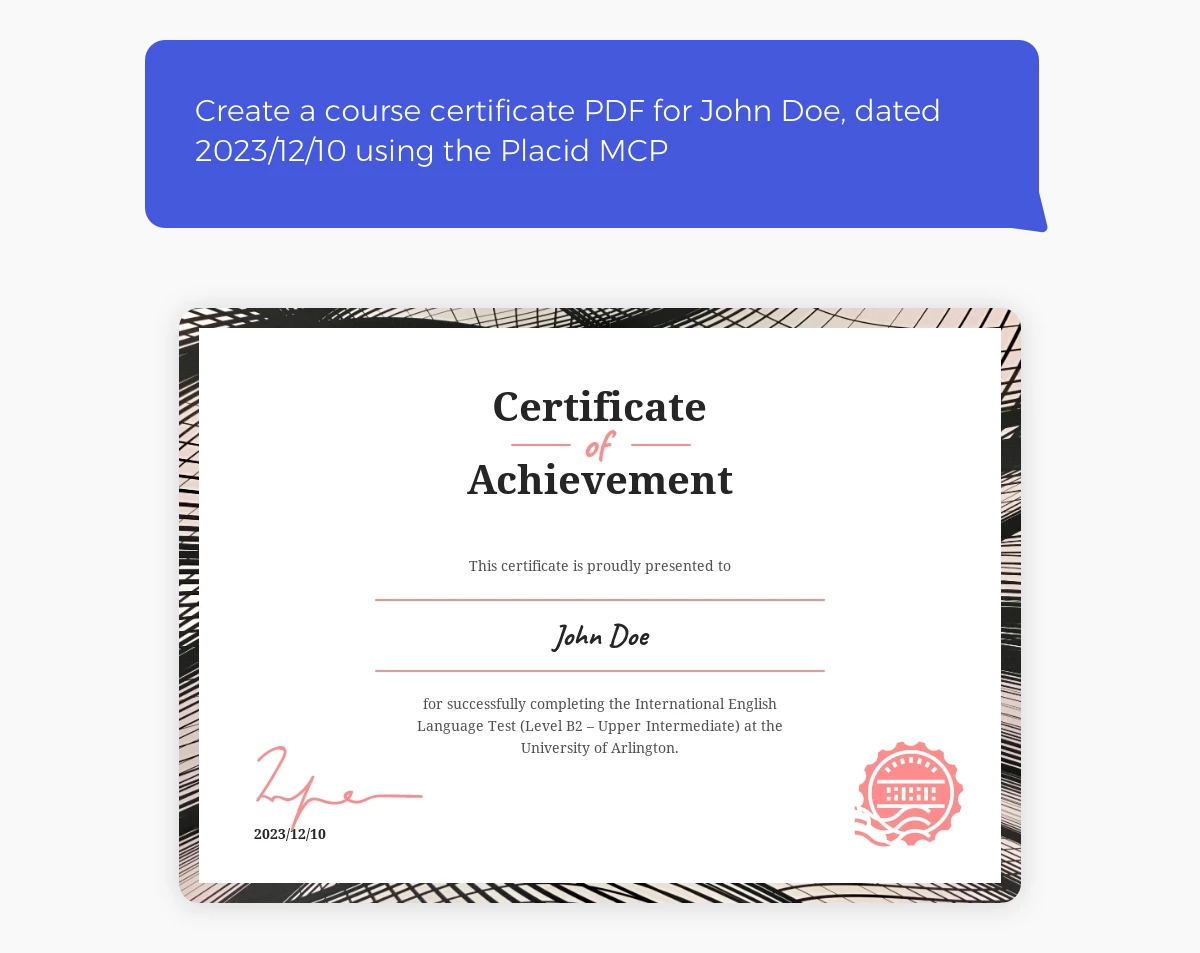
Which AI apps & agents can use Placid MCP?
- AI chat UIs & IDEs: You can connect Placid MCP to desktop apps or IDEs like Claude, Cursor, Windsurf, VS Code and more
- Automation tools: Add Placid MCP as a step in your workflow automations with tools like n8n or Make
- Agent frameworks: If you build agentic apps with frameworks like LangChain or LlamaIndex, you can add Placid MCP to your tools
...and there might be even more possibilities in the future! 🔮
Add the MCP integration to your Placid project
First, set up a Placid project with an MCP integration. Create a new project in Placid, or add the integration to an existing one in the Project Settings.
Create a template
Next, you will need a template for your images, PDFs or videos. A template is a bit like cloze text: You define the basic layout and decide which elements should be filled dynamically with data from your prompt later – like the author and quote text layers in this simple template:
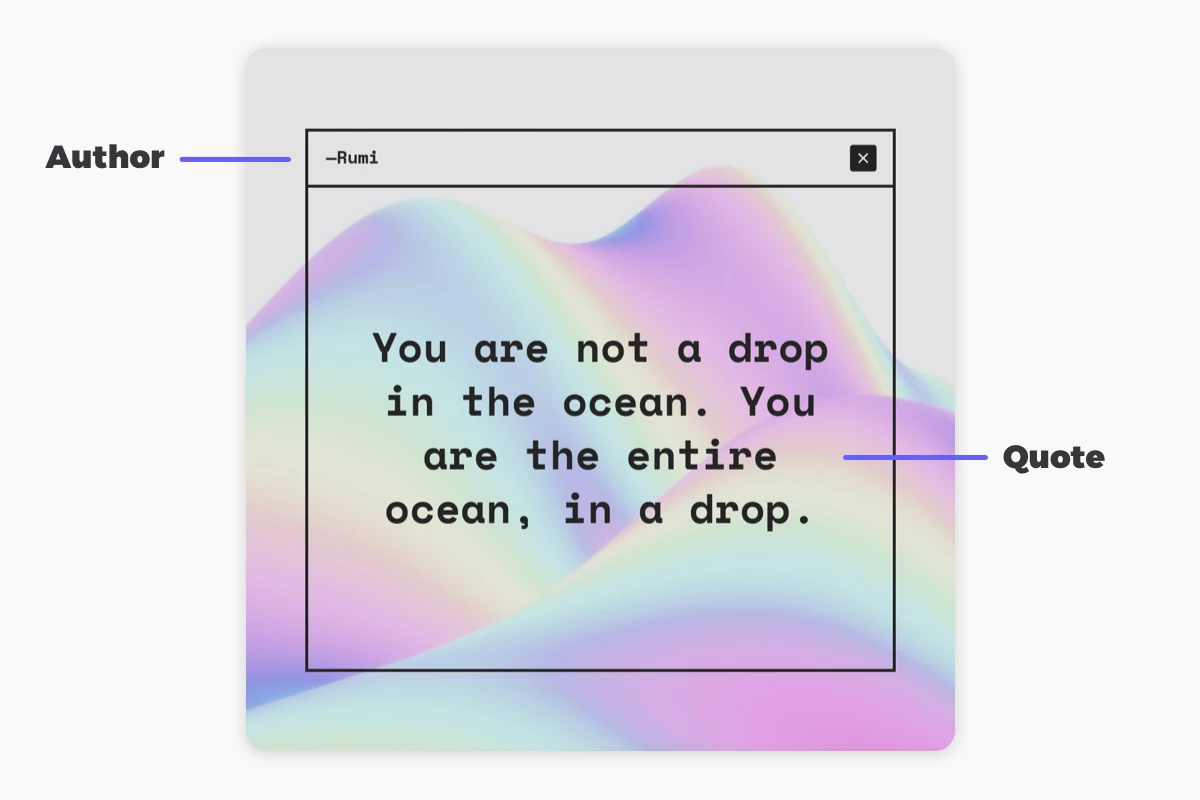
Go to your project's Templates tab. Here, you can create one or more dynamic templates for the MCP to use. You can design templates for your creatives with our drag & drop editor, but you can also choose one of our preset designs.
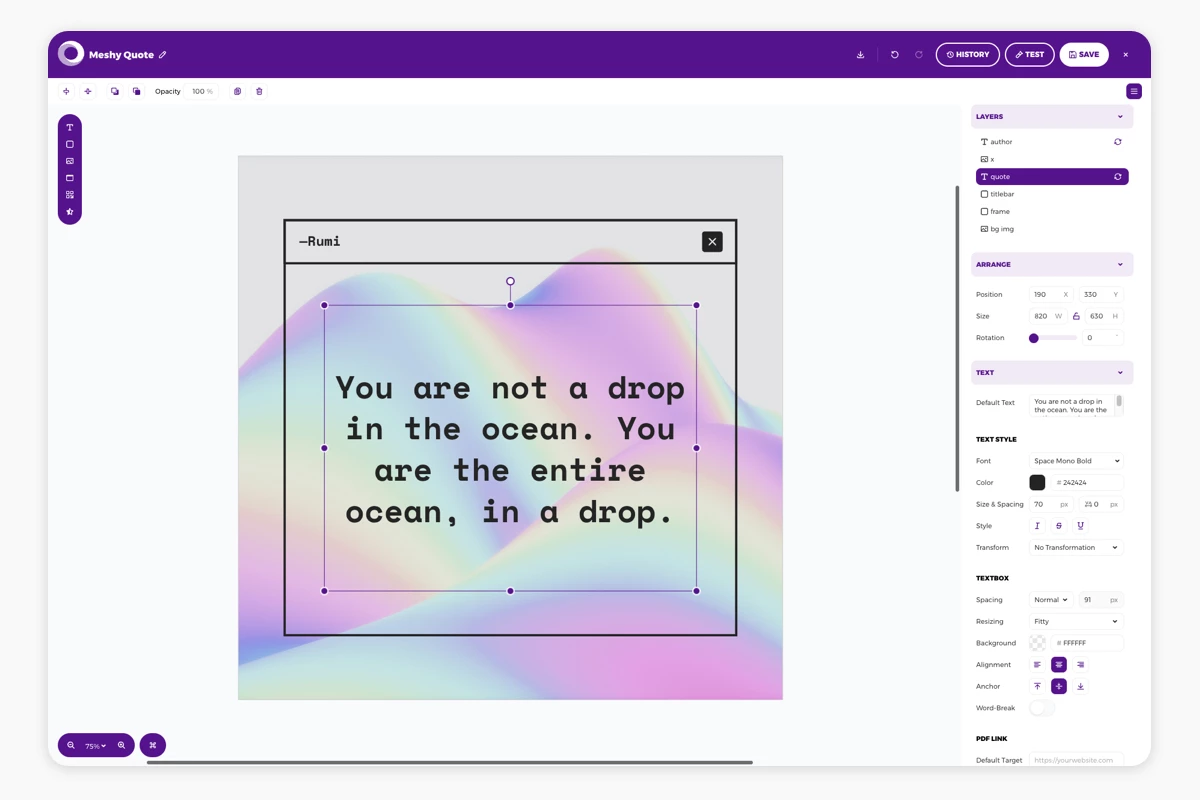
Tips:
- Define meaningful layer names in your templates, so the model can better understand what kind of content they contain (for example
headline,quote,course title,..) - Fill your layers with meaningful defaults – these will be the fallback values
- Uncheck the option Element is dynamic in the layer settings if that layer will not contain dynamic content (for example your logo), so they won't get changed accidentally
Configure Placid MCP
Go to the MCP page in your project's sidebar. There you will find all of the infos and settings you need to start integrating Placid MCP.
Enable Placid MCP
Make sure the MCP server is enabled and you have your MCP URL and Placid API key available.

Model settings of Placid MCP
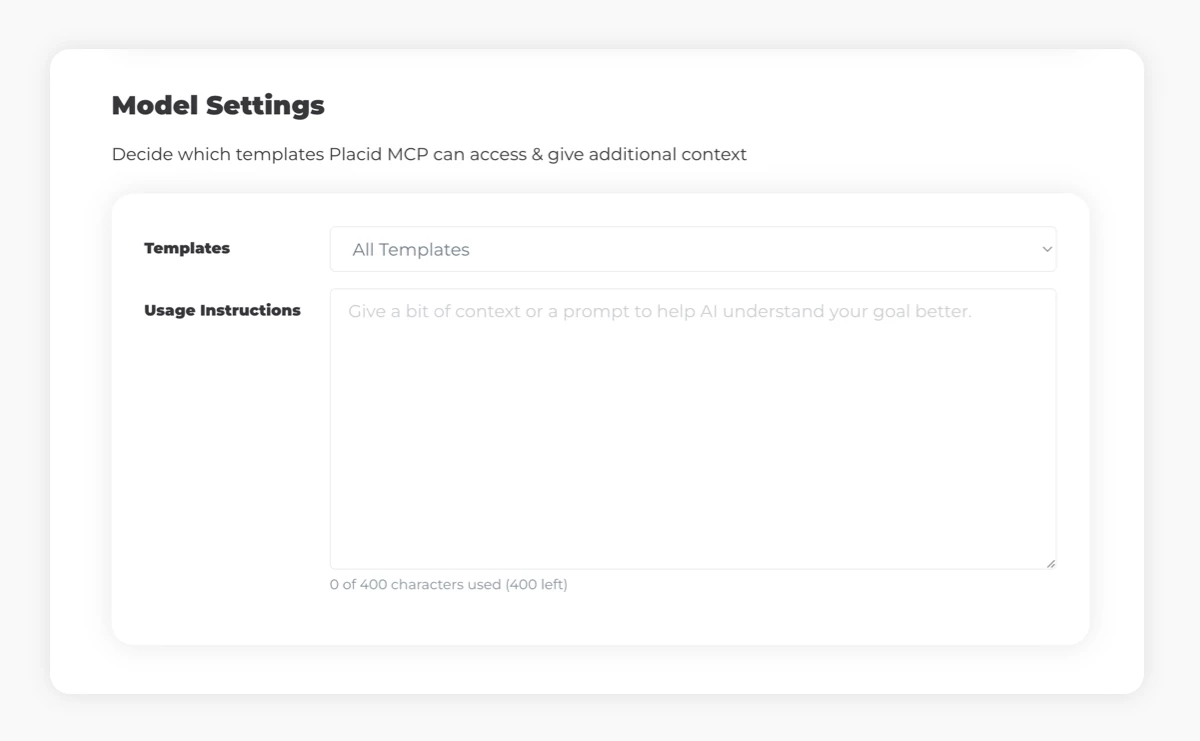
Manage Template Access
You can choose the templates that Placid MCP can access, so it doesn't accidentally use old designs or templates that are still work in progress.
We recommend creating an #mcp template tag and give Placid MCP access to all templates using this tag. That makes template management for AI usage a lot easier.
Add Usage Instructions
You can give Placid MCP additional context on how you want to use it. If you want it - for example - to be a course certificate generator, you can describe the scope within the Usage Instructions. Here's how that could look like:
This service generates course-completion certificates for my coaching programs. I’ll provide the student name, course title, date, and optional notes. Use the matching template, fill in placeholders, and return a final PDF file. Ask if info is missing, do not make information up.
This information is totally optional, but instructions to not interpolate or generate information (or ask for missing content) can make the process less error-prone.
Permission settings of Placid MCP
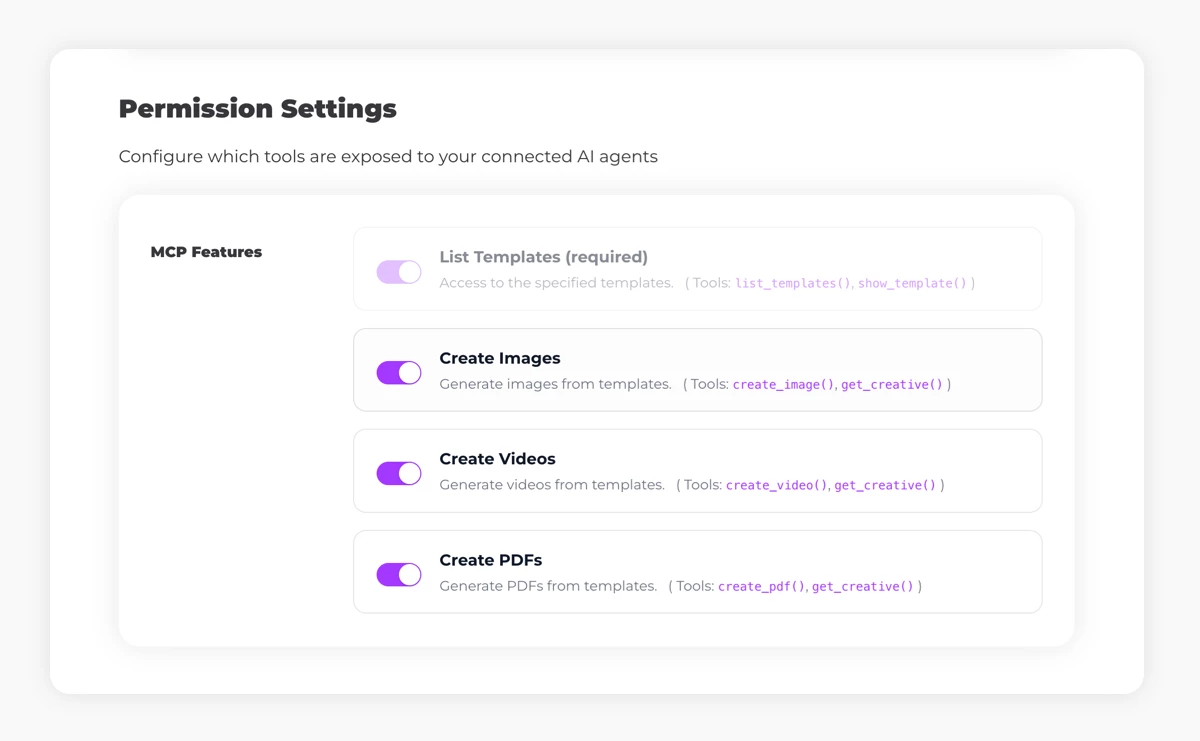
Decide if you want Placid MCP to flexibly create images, videos and PDFs, or if you want to restrict generation to a specific creative type. This gives you more control in the process!
Connect Placid MCP to your AI agent
How to exactly connect the Placid MCP depends on the AI app or client you are using. It works roughly the same across them all, but you will have to find out in their documentation how they handle adding an MCP server.
Also, this is subject to rapid change (and will probably become more convenient), as MCP support continuously improves!
Option 1: Via your AI app's UI
If you use an AI desktop app like Claude Desktop, or a web UI of tools like n8n or Make, find the option to connect a remote MCP server in the settings, or via an MCP client workflow node.
When prompted to enter an endpoint or server URL, use the custom Placid MCP URL that you can find on the MCP page in the sidebar your Placid project.
For information on how to authenticate, follow the Placid MCP Authentication instructions.
Option 2: Via JSON configuration
Some tools don't offer a UI for adding MCP tools, but let you add them manually. This is usually managed via a JSON configuration file called mcp.json or mcp-config.json.
As an example: In Claude Code, adding an MCP from a remote server (like ours) with Bearer Token Authentication works like this:
claude mcp add --transport http placid-mcp https://mcp.placid.app/CUSTOM-URL \ --header "Authorization: Bearer PLACID-API-TOKEN"This basically just adds the following to your JSON config file:
{
"mcpServers": {
"placid-mcp": {
"type": "http",
"url": "https://mcp.placid.app/CUSTOM-URL",
"headers": {
"Authorization": "Bearer PLACID-API-TOKEN"
}
}
}
}You should be able to find instructions on how to add an MCP server in your app's documentation. Here are some links that may help you find the instructions for your tool/app:
- Add an MCP server to Claude Code
- Add an MCP server to Cursor
- Add an MCP server to Windsurf
- Add an MCP server to VS Code
- Use a remote MCP server together with the OpenAI API
Missing your AI application in the list and don't know where to find the info?
Placid MCP Authentication
Authentication works via your Placid project's API token. It can be provided in two different ways:
- Via Bearer Token Authentication (if your AI tool supports this)
- Alternatively you can add the API token as a parameter in the MCP server URL (e.g.
https://mcp.placid.app/xxxxx-xxxx-xxx-xxxxx?api_token=PLACID-API-TOKEN)
You can find your token on the API token page in your project's sidebar in placid.app.
Please note: If you change the permission settings for Placid MCP in your project, you might have to reinstall it in your AI applications. (Most apps do not support ongoing tool discovery, so these instructions are only delivered and read once!)
Write prompts to generate your creatives
Now that you're set up, you can experiment with writing prompts in your AI apps to generate visuals with Placid MCP. The model will always try to understand these things:
- Which type of creative do you want? (image / PDF / video)
- Which template should be used?
- What content should be used (or text generated) to fill into the template layers?
You get the best results if you clearly answer these questions within your prompt!
Tips for writing Placid MCP prompts
- It works best to tell your model explicitly to use Placid MCP if you have a generation request
- Be very descriptive in your template and layer titles, so AI can understand how to use them
- If you want to use media like images or videos, provide public links that Placid MCP (and Placid API) can access
- If you want to make sure a specific template is used, include the template ID in your prompt
- If you already have (semi-)structured content available within your workflow that you would like AI to map and fill into your template layers "as is", providing it in a JSON-like structure works well
We're excited to see the variety of workflows our MCP will be used, and will keep improving it. If you have any ideas, feedback or questions, please
















